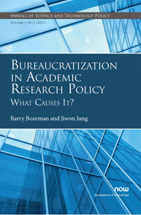Bureaucratization in Academic Research Policy: What Causes It?
By Barry Bozeman, Arizona State University, USA, bbozeman@asu.edu | Jiwon Jung, Arizona State University, USA, jiwon.jung@asu.edu
Abstract
Senior academic researchers and research administrators whose careers have spanned decades have witnessed a monotonic trend in the growth of bureaucratic rules and structures pertaining to research policy. The increase in administrative requirements takes many forms, some directly related to research and others tangentially related. While the onslaught of rules has increased administrative burdens, not all of these requirements are red tape; many are useful and even vital. But when taken together, the amount of administrative procedure and documentation associated with research conduct and administration becomes crushing. Others have well documented the bureaucratization of university research policy and administration. Our primary purpose is to explain why rules and regulations and the bureaucratic structures supporting them continue to grow, extracting an ever-greater toll on time and resources available for actual research. Absent an explanation of the growth of administrative burden, it is not possible to provide valid assessment of the effectiveness of rules and regulations pertaining to research policy. We examine the problem from the lens of a well-developed theory of organizational red tape specifically, applying it specifically to the problem of research administration red tape. The theory suggests that the increase in research policy bureaucratization can be explained chiefly by three different factors: crisis response, pressures for bureaucratic over-control, and the use of research policy for side-payments, both social side-payments (to achieve social goals not directly related to research) and political side-payments (conferring factor with political supporters by proving rules or policy symbols favored by them). To help elaborate the theory as well as to provide context, we provide case illustrations of ranging from the vitally important (research misconduct) to mundane bureaucratic requirements (standardization of required biosketches).
Bureaucratization in Academic Research Policy: What Causes It?
In the U.S. and throughout most of the world, university research is becoming increasingly bureaucratized. Remarkably, there is almost no scholarly attention devoted to answering the question of what explains the continual growth in rules and regulations surrounding publicly funded research. Many efforts have been made to document the growth of rules and administrative burden in research policy – blue ribbon panels have been convened and made recommendations about reducing rules and their costs – but the causes of this bureaucratization have generated much less systematic explanation.
Bureaucratization in Academic Research Policy: What Causes It? explains the reasons of bureaucratization and, in doing so, relies on theory and research about red tape and bureaucratic pathology. The monograph is organized as follows: The first section provides a brief, necessary preamble to organizational analysis – a review and conceptual demarcation of bureaucratization, red tape and formalization. After clarifying closely related concepts, the authors review some of the studies documenting the bureaucratization of research policy and administration in the U.S. and the responses to the bureaucratization, both institutional responses and responses and attitudes of individual investigators. The next section introduces theory of rules and red tape, the theory-base is used as a lens to asking the study’s key question concerning the growth of rules in research policy and administration. After providing a theory base, the authors turn to the core question of the paper: What explains the continual growth in rules and regulations surrounding publicly funded research? And provide a conceptual model to answer this question.
Finally, the monograph examines key elements of the conceptual model in terms of a variety of government rules and procedures promulgated, ones that almost always have good intentions but, when taken together, vastly increase administrative burden while only rarely demonstrating the social value purchased by the administrative burden.
